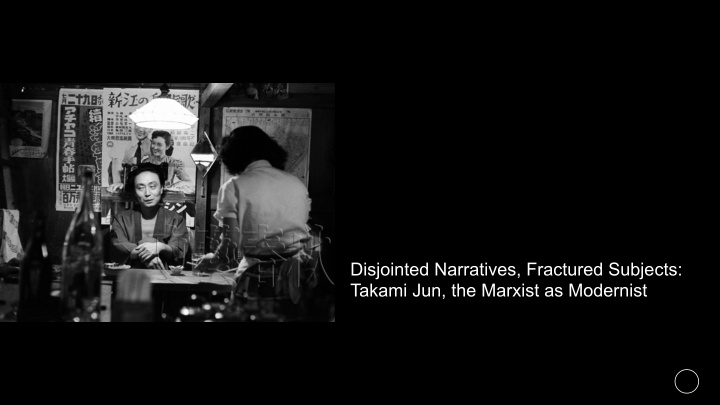



Disjointed Narratives, Fractured Subjects: Takami Jun, the Marxist as Modernist
Koky ū wasureubeki (Let Old Acquaintance Be Forgot) Takami Jun (1907–1965) (Shortlisted for the first Akutagawa prize in 1935)
Disjointed narratives: temporal structures of the first and the last chapter of the novel If A → B → C → D → E is normal chronological succession, then … Chapter One D : Ozeki in the barber shop excusing himself with his nervous exhaustion ( shinkei suijaku ) → B (unidentified past moment) : retrospection about the colleague who told him about nervous exhaustion → C: the following morning after B : Ozeki sees in the morning paper an advertisement for a medicine for nervous exhaustion → C : same day Ozeki has lunch with the same colleague → A : eight years before at higher school : retrospection about the day Ozeki shared a table with Shinohara in the school canteen → the narration goes back to D : ‘While the narrator was rambling on, our hero Ozeki Kenji finished his haircut and returned to his dull home.’ D → B → C → A → D (B, C, and A are Ozeki’s subjective retrospections) Chapter Nine C: Ozeki receives a letter telling of Sawamura’s suicide and uses it as a pretext to go out (actually heading for Akiko’s apartment) → C : the narrative ‘cuts’ to Shinohara, who at this same time is waiting for Fumie at Shinbashi station → B: Shinohara’s morning : his thoughts when opening a letter and finding about Sawamura’s death → E: some time after Sawamura’s funeral : a memorial piece about Sawamura, written by one Makino and ‘quoted’ by the narrator → again C : Shinohara meets the woman who lives in the apartment next to his → A: retrospective digressions about this woman and her scandalous way of life, the quarrel with her husband and Shinohara’s intervention → back to C : Shinohara waiting for Fumie → D: Shinohara’s date with Fumie. Synchronicity : the other characters and their plots at this moment: Akiko and Ozeki, Tomonari and Akadako, Matsushita’s wife. C (Ozeki) → C (Shinohara) → B → E → C → A (Shinohara’s retrospection) → C → D (synchronicity)
The transgressions of the narrator § I would like to draw the attention of the reader to Ozeki’s lustfulness: the reader might have caught a glimpse of it earlier in the dinner scene. Despite his indecisiveness, Ozeki has sharp and keen amorous instincts. His lust will play a very active part further on in this narrative . (22) § Instead of recording here the exchange of recollections that took place, I would like to sketch briefly the history of their friendship. What do you think? (55). § Why didn’t you refuse, Ozeki? A forceful ‘No!’ would have probably cooled the reckless arrogance of your roommate . My (hissha no) heart aches at the sight of your wretched figure ; I almost cannot bear writing about you . (64) § Come to think of it, what a ridiculous detour did our story take! While the author was rambling on , our hero Ozeki Kenji finished his haircut and returned to his dull home. (15) § The reader might harbour feelings of disbelief, because the present Akiko, namely the image of her which the reader has painted in his imagination after reading the beginning of the chapter, and Akiko as she appeared in the retrospections following, are quite different. This, however, is not a lapse on the part of the narrator. I did intend to describe this change in her in a composed, assured manner, but while I had abandoned these two [Shinohara and Akiko], they got ready to go out and would leave the apartment any moment now. I don’t really mind them going out, but there was a conversation between them that should not be missed (51–52). (page numbers refer to Takami Jun zensh ū vol. 1, Tokyo: Keis ō shob ō , 1977, my emphasis).
The cultural revival and the logic of tenk ō § The writer must complete within himself a new world. This perfected inner world radiates a light whose violent pulsations touch the heart of the reader and draw him forcefully into the world of the writer. (Hayashi Fusao,’Sakka no tame ni’ in Muramatsu Takeshi (ed), Showa hihy ō taikei, vol. 1, Tokyo: Banch ō shob ō , 1968, pp. 201–202) § It was the Japanese kokutai that opened the path of tenkô for me … I managed to free myself completely from the constraints of abstract theory. I have never been much of a theorist. With tears in my eyes, I will share my life with the life of the Yamato people; with tears in my eyes I will lend my strength to the advance of the nation. (Hayashi Fusao, ‘ Tenk ō ni tsuite’ in Hayashi Fusao chosakush ū , vol. 3, Tokyo: Tsubasa Shoin, 1969, p.384). § The mountains give birth to dreams. How pleasant it must be to walk in these mountains!...The mountains give birth to beauty. The sublimely beautiful form of the mountains inspires aesthetic feeling in Ono. In that way, the mountains become spiritualized ( seishinka sareru ). (Kobayashi Morito quoted in Fujita Sh ō z ō , ‘Sh ō wa 8-nen o ch ū shin to suru tenk ō no j ō ky ō ’ in Tsurumi Shunsuke and Shis ō no kagaku kenky ū kai (eds), Tenk ō : ky ō d ō kenky ū , Tokyo: Heibonsha 1959, p. 49)
Eisenstein and Chaplin, Hollywood 1930. Leonid Sokov, Stalin and Marilyn, oil on canvas, 2007.
Recommend
More recommend